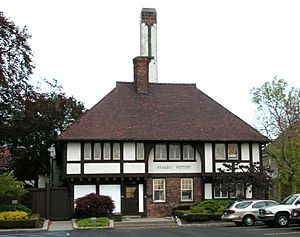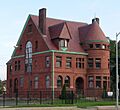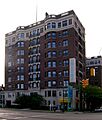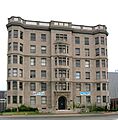East Jefferson Avenue Residential TR facts for kids
Quick facts for kids |
|
|
East Jefferson Avenue Residential TR
|
|
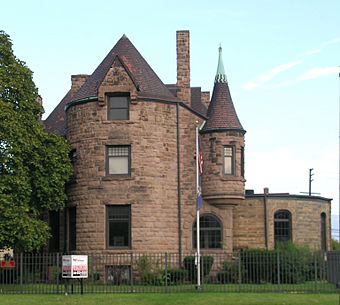
|
|
| Location | Detroit, Michigan, U.S. |
|---|---|
| Built | 1835–1931 |
| Architect | Charles N. Agree; Robert O. Derrick; Albert Kahn; Malcomson & Higginbotham; George D. Mason; William Henry Miller; Charles Noble; Shepley, Rutan & Coolidge; Mortimer L. Smith & Sons; J. Will Wilson and Otto Misch |
| Architectural style | Gothic Revival, Richardsonian Romanesque, Queen Anne, Italianate, Art Deco, Georgian, Federal, Late 19th and 20th Century Revivals, Renaissance Revival |
| MPS | East Jefferson Avenue Residential TR |
| NRHP reference No. | 64000324 |
| Added to NRHP | October 9, 1985 |
The East Jefferson Avenue Residential District in Detroit, Michigan, is a special area recognized for its historic buildings. It was added to the National Register of Historic Places on October 9, 1985. This district includes many single-family homes and apartment buildings. These buildings were constructed over almost a century, from 1835 to 1931. The area is located on the lower east side of Detroit, near the Detroit River.
Contents
History of East Jefferson Avenue
The road we now call East Jefferson Avenue has been important since Detroit's earliest days. It was first known as the "River Road." This road ran alongside the Detroit River and connected French farms to the center of Detroit.
After a big fire in 1805, a judge named Augustus Woodward created a new plan for the city. He made the old Ste. Anne Street wider and renamed it "Jefferson Avenue." This was done to honor Thomas Jefferson, who was a very important person at the time.
Jefferson Avenue quickly became a busy center for businesses in Detroit. By 1820, more than half of the city's businesses were located there. Many important people also lived along Jefferson Avenue. As Detroit grew, Jefferson Avenue was one of the first streets to get new services. It received iron water pipes in 1838 and a horse-drawn bus line in 1847. Later, it got horse-drawn rail in 1863, electric lights in 1883, and asphalt pavement in 1892.
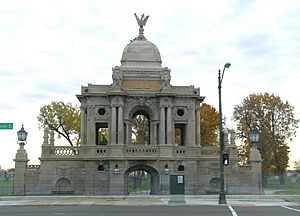
After the American Civil War, many wealthy Detroit citizens built impressive homes along Jefferson Avenue. These homes showed off popular styles like Gothic Revival, Richardsonian Romanesque, Queen Anne, and Italianate.
As the 1900s began, the area around Jefferson Avenue became more industrial. Rich residents started moving further away from the city center. This was because streetcar lines and later, cars, made it easier to travel. However, Detroit's economy was booming, and many new people moved to the city. This led to a high demand for new homes. East Jefferson Avenue became a popular spot for new luxury apartment buildings, especially in the 1920s and 1930s.
After World War II, East Jefferson Avenue became more commercial. New modern stores and businesses were built. Still, many historic buildings in the area have been saved and preserved.
Architectural Styles and Buildings
The East Jefferson Avenue Residential District includes many important buildings. These structures show off the "high style" architecture of their time. This means they were built with great care and often had fancy designs. Most of these buildings still look much like they did when they were first built.
The buildings in this district can be grouped by when they were built and what they were used for:
Early Single-Family Homes
This group includes homes built by important Detroit citizens before the Civil War. These houses, like the Joseph Campau House (1835) and the Moross House (1855), might look simple today. But when they were built, they were very fashionable homes for leading families.
Late 19th and Early 20th Century Homes
This group features larger, more detailed single-family homes. Wealthy Detroiters built these houses in the late 1800s and early 1900s. Examples include the John N. Bagley House (1889) and the William H. Wells House (1889). These homes were designed by famous architects and show off popular styles of the time. Many are found in the Indian Village Historic District.
Luxury Apartment Buildings
In the early 1900s, large, fancy apartment buildings started appearing on East Jefferson Avenue. These were the first multi-unit buildings in an area that used to have only single-family homes. Early examples are the Pasadena Apartments (1902) and The Palms (1903). Later, even bigger buildings like the Garden Court Apartments (1915) and the Alden Park Towers (1922) were constructed. These apartments were very spacious and luxurious.
Smaller Apartment Buildings
The fourth group includes smaller, but still well-designed, apartment buildings. These were built in the 1910s and 1920s. They were made for upper-middle-class people, like professionals or workers in the growing automobile industry. Buildings like the Manchester Apartments (1915) and the Somerset Apartments (1922) offered good quality rooms, even if they were not as grand as the luxury apartments.
Images for kids
-
Alden Park Towers (1923)
-
John N. Bagley House (1889)
-
Joseph Campau House (1835)
-
Garden Court Apartments (1915)
-
Hibbard Apartment Building (1924)
-
The Kean (1931)
-
Manchester Apartments (1915)
-
The Palms (1903)
-
Arthur M. Parker House (1901)
-
Pasadena Apartments (1902)
-
Somerset Apartments (1922)
-
Frederick K. Stearns House (1902)
-
William H. Wells House (1889)
-
The Whittier (1922, 1926)
-
Croul-Palms House (1881)
-
Thomas A. Parker House (1868)
-
Charles Trowbridge House (1826)
-
Moross House (1855)
See also
 In Spanish: Distrito Residencial de East Jefferson Avenue para niños
In Spanish: Distrito Residencial de East Jefferson Avenue para niños


